Advertisement
Teaching a raw recruit how to fish is easier said than done — but well worth the effort.
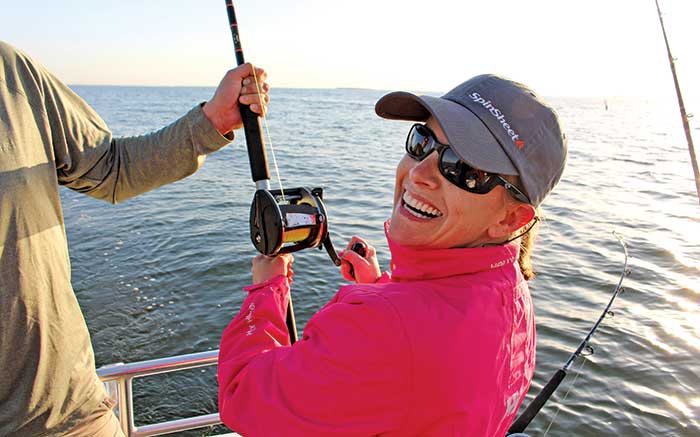
First-time anglers handed conventional gear should always get level-winders if at all possible.
You're about to break in a new beginner to bassing? Teach a tenderfoot how to troll? Go grouper fishing with a greenhorn? There are so many details to keep track of and mistakes about to be made that it can seem overwhelming for the master, much less the apprentice. But by focusing on a few critical areas, you'll have that rookie reeling in fish in no time — and hook them on fishing forever.
Caution With Kids
Taking a kid fishing is one of the most common ways learned anglers end up teaching a newbie, and while it presents some unique challenges, it's also one of the most rewarding experiences an angler will ever have. Seeing young faces light up with huge smiles and hearing the laughter when the first fish gets swung aboard will be priceless payback for all your efforts. But before getting started, remember:
- Safety comes first, obviously, but things old hands consider second nature can be dangerous for kids. Hooks are the most obvious example. When you're getting them started, you should handle tasks like baiting up, tying on lures (even if they know the knots), and unhooking the fish.
- Eliminate treble hooks completely. Yes, they're often more effective at hooking fish, but they're often more effective at hooking people, too.
- Equip kids with short rods. Long rods tend to swing around, smack into things, and extend the potential "arc of destruction" created by a kid who's casting.
- Position kids on boats or on docks where they have a clear back-cast to reduce the chance of them accidentally hooking someone else.
- Keep bait knives sheathed or stowed away when not in use. Never, ever drop a knife into a bait bucket, where unsuspecting hands may later reach.
- Be quick to postpone trips with iffy weather. If kids are miserable due to wind, waves, or rain, they won't have fun no matter how good the fishing is.
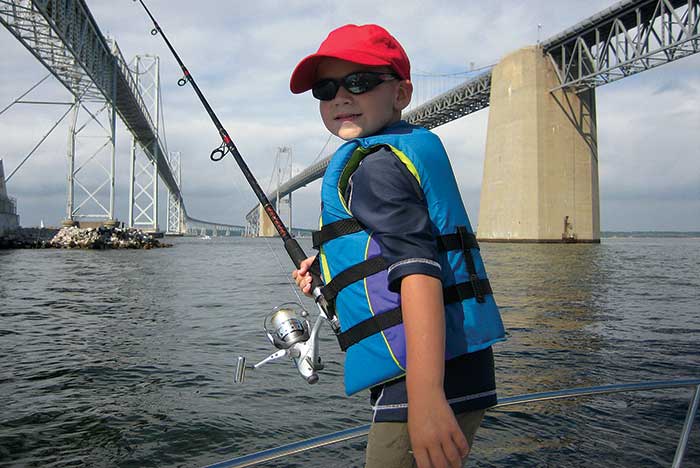
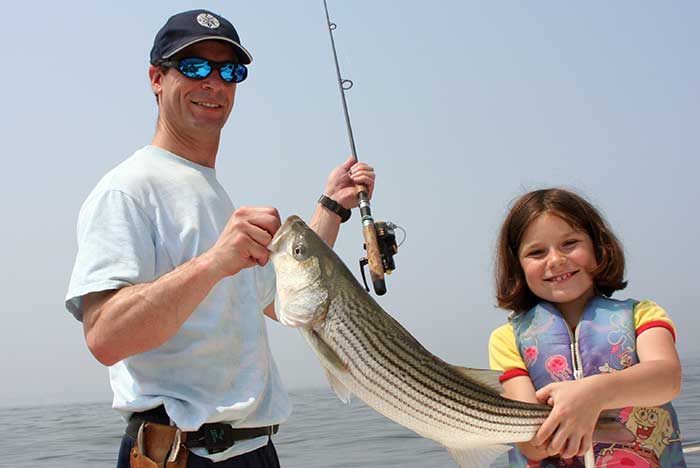
It's rare to find newbie anglers more enthusiastic than kids!
As long as you keep the kids safe and get a bite or two, most of them will take to fishing in a heartbeat. Still, fishing isn't ever a sure thing, and slow periods can lead to boredom very quickly with youngsters. So be prepared for it and give them odd jobs to keep them busy, like reeling lines up to check them, reorganizing the tackle box, or practicing a knot with a piece of rope. Most importantly, let them set the rod down when they want to and don't turn fishing into a work-like task.
Reeling For Recruits
One of the most basic but toughest tasks facing a newbie angler of any age is learning to use the gear. Rather than handing someone a rod and reel the moment you arrive at a hotspot, pull up short of that spot, stop the boat, and take a few minutes to give them a rundown on how the gear works. Let them know that you haven't reached the fishing zone yet and that you first want to take a few minutes for a training session. This way you can explain things in a calm setting before any excitement begins. Demonstrate basics like casting and retrieving, then hand them the rod and reel and let them practice a bit in this zero-pressure environment.
You can make this process easier by equipping them with the easiest-to-use gear you have, even if it isn't best for the fishery. Handing someone a baitcaster and trying to teach them to cast it in an hour or two, for example, is an exercise in futility. But most people will be able to start slinging a spinner in short order. Similarly, if you'll be trolling, start with level-winder gear that they can crank up right off the bat without a big learning curve. Then you can show them how the worm gear on the level-winder works as they're bringing in line. Later, you can introduce them to conventional gear without a level-winder, and they'll understand what they need to do to lay the line down evenly on the spool.

It's hard to tell who’s having a better time, the old salt or that new recruit.
Also be sure to point out the critical mistakes newbies commonly make, reeling in slack line being the king of them all. (Tip-wraps, forgetting to open the bail when casting, and failure to check behind you before back-casting are a few other must-mentions.) Remind yourself that this newly minted angler will likely do all of these things at some point anyway, simply because no one remembers everything, and everyone makes mistakes. When you do begin fishing, keep an eye on them and offer gentle reminders as you see these mistakes being made.
Advertisement
Teaching The Tactics
There will be times when a new angler quickly masters using the gear, yet can't seem to catch a fish. The most common cause? Not understanding two things: how to feel their rig and/or lure with their rod, and not understanding how and when to set the hook. You can mitigate this by choosing tactics and gear that don't require much angler input in the first place. Fishing bait on a circle hook, for example, you can simply sit the rods in holders and tell the novice to reel in the fish when the rod bends over.
That's simple enough, and going this route is great for starting out. But the fisheries in your neck of the woods may not allow for such techniques. Even if they do, sooner or later most people will want to move on to more active forms of angling. At this point, you'll have to teach them how to feel with their gear and set the hook when a fish strikes. Critical in this education is first explaining how an angler keeps slack out of the line and maintains tension so they can feel nibbles and strikes.
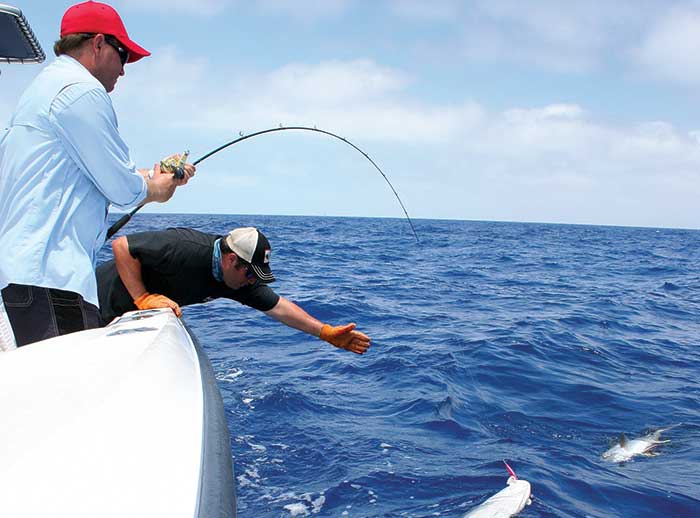
Remind new anglers of how important it is to keep a bend in the rod, as they maintain tension at all times.
A great way to communicate the importance of this factor to a newbie is to put a relatively heavy weight on the end of a fishing line and let them drop it straight down to the bottom. Then show them how to keep the tip positioned so they maintain tension and feel the weight. Next, take another rod and use it to gently tap their line. After confirming that they feel the tapping, have them open the reel and let out slack. Then tap on the slack line, and draw their attention to the fact that they can feel very little or nothing at all without tension on the line.
While that lesson is usually enough to get the message across, remember that you can't expect instant finesse right from the start. It takes time and experience to learn how to maintain tension as you jig or work a lure, and to figure out just how much line to take in or let out to maintain tension. So when you put a beginner into the position of applying this lesson, make it easier for them. Put a heavier weight on the line so they'll have less of a problem feeling it, give them a lure (like a lipped plug or a paddle-tail) that has action of its own so they don't have to worry too much about adding action with the rod, or choose a bait that can be left in a static position until a fish bites.
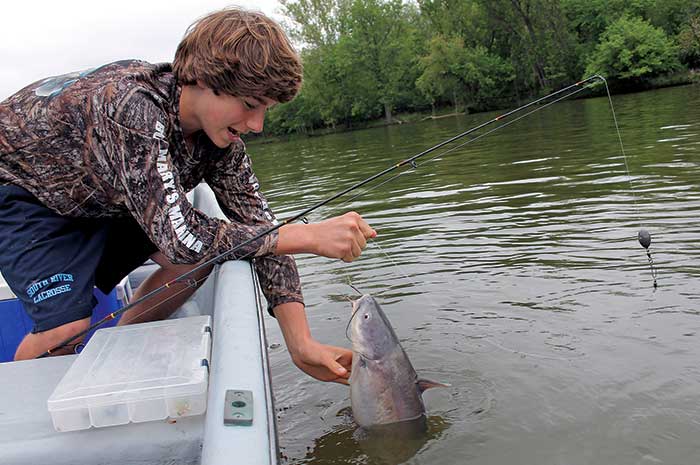
Fishing with baited circle hooks is a good starting point because you can simply allow the fish to hook themselves.
It doesn't do much good to feel the fish, however, if the angler isn't prepared to set the hook (excepting the use of circle hooks, as mentioned above). An effective way to teach an angler how to set the hook is to tie a swivel or a loop to the end of a line and secure it to a cleat on your boat. Then hand the ambitious amateur the rod it's attached to and (after setting a light drag) have them hold it at a 90-degree angle to the cleat and reel until there's minimal tension. Explain how they need to jerk back hard enough to hear the drag when a fish hits, then tap the line near the cleat so they feel a "bite." Then give them a few trial runs. As they perform their faux hook-sets, show them the difference between initiating a hook-set with your wrist to maximize the speed (versus using your shoulder or arm). This is also a good time to mention that it's critical to maintain tension once a fish is on the line, to keep that hook firmly embedded.
The Golden Rule
Whenever you're teaching a newbie to fish, there's one golden rule: Don't be surprised when that newbie messes up, and don't get upset or shout about it. It's a given that new anglers will make plenty of mistakes, and you should plan on losing some fish (and often some gear as well), when teaching someone how to fish. When they break off a snagged lure or lose that new world record fish because they dropped the rod tip too fast and allowed slack into the line, simply smile and remind them that it's all part of fishing. Remember that above all else, you're both out there on the water chasing the finned critters to have fun. And before you know it, that newbie will probably become a full-fledged fishing buddy.
